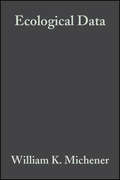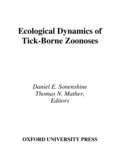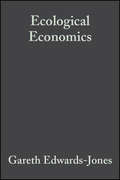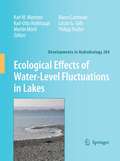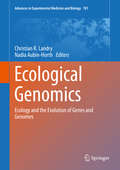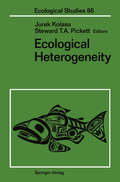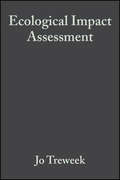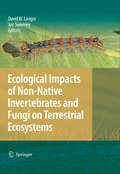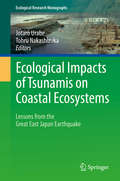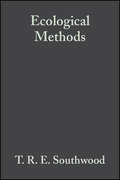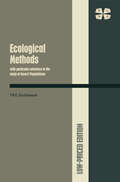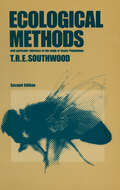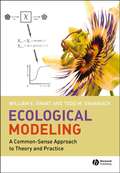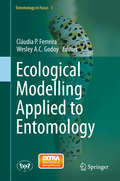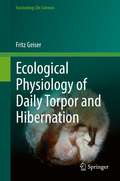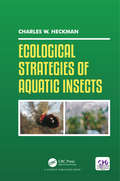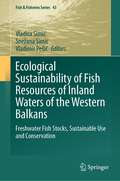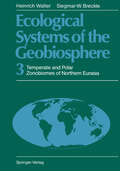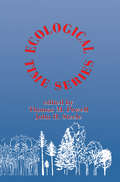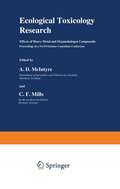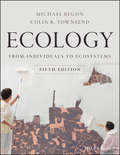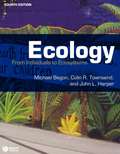- Table View
- List View
Ecological Data: Design, Management and Processing
by William K. Michener James W. BruntEcologists are increasingly tackling difficult issues like global change, loss of biodiversity and sustainability of ecosystem services. These and related topics are enormously challenging, requiring unprecedented multidisciplinary collaboration and rapid synthesis of large amounts of diverse data into information and ultimately knowledge. New sensors, computers, data collection and storage devices and analytical and statistical methods provide a powerful tool kit to support analyses, graphics and visualizations that were unthinkable even a few years ago. New and increased emphasis on accessibility, management, processing and sharing of high-quality, well-maintained and understandable data represents a significant change in how scientists view and treat data. These issues are complex and despite their importance, are typically not addressed in database, ecological and statistical textbooks. This book addresses these issues, providing a much needed resource for those involved in designing and implementing ecological research, as well as students who are entering the environmental sciences. Chapters focus on the design of ecological studies, data management principles, scientific databases, data quality assurance, data documentation, archiving ecological data and information and processing data into information and knowledge. The book stops short of a detailed treatment of data analysis, but does provide pointers to the relevant literature in graphics, statistics and knowledge discovery. The central thesis of the book is that high quality data management systems are critical for addressing future environmental challenges. This requires a new approach to how we conduct ecological research, that views data as a resource and promotes stewardship, recycling and sharing of data. Ecological Data will be particularly useful to those ecologists and information specialists that actively design, manage and analyze environmental databases. However, it will also benefit a wider audience of scientists and students in the ecological and environmental sciences.
Ecological Dynamics of Tick-Borne Zoonoses
by Daniel E. Sonenshine Thomas N. MatherThe ecological relationships found to exist between tick vectors and pathogens in their zootic cycle can profoundly influence patterns of transmission and disease for humans and domestic animals. This book examines the ecological parameters affecting the conservation and regulation of tick-borne zoonoses as well as the geographic and seasonal distributions of those infections. Written by an eminent authority on the subject, the book will be sought after by students and researchers in ecology, invertebrate zoology, parasitology, entomology, public health, and epidemiology.
Ecological Economics: An Introduction
by Gareth Edwards-Jones Ben Davies Salman S. HussainEcological economics is an exciting interdisciplinary field of study that combines insights from the natural sciences, economics, philosophy and other fields to develop innovative approaches to environmental problems. It draws on a wide range of analytical perspectives, some radical others more conventional, to build a more complete understanding of human-ecosystem interactions. Current research in the field includes work on nature conservation, land use planning, pollution control, natural resource management, and environmental impact assessment/evaluation. Ecological Economics provides a comprehensive introduction to the core themes, presented in a clearly structured style, with chapters tailored specifically to readers without any economic or philosophical training. There is an emphasis throughout on the complementary roles of economics, ethics and ecology in environmental decision-making processes. The book reviews the evolution of important ideas in the field, explores the fundamental philosophies underlying different approaches to environmental problems, explains in detail the specific tools and techniques used in these approaches, and gives numerous examples of how they can be applied. Special importance is attached to understanding both the advantages and limitations of different analyses, in order to provide a balanced and coherent view of how these different approaches interrelate and how their roles vary in different contexts. Written by three authors specializing in ecology, economics and philosophy, this textbook provides an excellent introduction to the field of ecological economics for students in the natural sciences and other environmental disciplines. It will also be of interest to a wide range of professionals and researchers involved in environmental management and policy, and thers including economists seeking to broaden their knowledge of new methodologies and approaches. Further reading suggestions and extensive references are provided for those interested in pursuing particular themes beyond the introductory level. The first introductory ecological economics text written specifically for natural scientists. Assumes no prior knowledge of economics or philosophy. Emphasises the complementary roles of ecology, economics and ethics in environmental decision-making processes. An emphasis on clarity and accessibility throughout.
Ecological Effects of Water-level Fluctuations in Lakes (Developments in Hydrobiology #204)
by Karl M. Wantzen Lászlo G. Tóth Marco Cantonati Philipp Fischer Martin Mörtl Karl-Otto RothhauptMost aquatic ecosystems have variable water levels. These water-level fluctuations (WLF) have multiple effects on the organisms above and below the waterline. Natural WLF patterns in lakes guarantee both productivity and biodiversity, while untimely floods and droughts may have negative effects. Human impacts on WLF have led to a stabilization of the water levels of many lakes by hydraulic regulation, untimely drawdown due to water use, or floods due to water release from hydropower plants in the catchments. This book provides a first review in this field. It presents selected papers on the ecological effects of WLF in lakes, resulting from a workshop at the University of Konstanz in winter 2005. Issues addressed here include the extent of WLF, and analyses of their effects on different groups of biota from microorganisms to vertebrates. Applied issues include recommendations for the hydrological management of regulated lakes to reduce negative impacts, and a conceptual framework is delivered by an extension of the floodpulse concept for lakes. Current impacts on water use, including increasing demands on drinking and irrigation water, hydropower etc., and climate change effects on WLF make this book an essential resource for aquatic ecologists, engineers, and decision-makers dealing with the management of lake ecosystems and their catchments.
Ecological Genomics: Ecology and the Evolution of Genes and Genomes (Advances in Experimental Medicine and Biology #781)
by Christian R. Landry Nadia Aubin-HorthResearchers in the field of ecological genomics aim to determine how a genome or a population of genomes interacts with its environment across ecological and evolutionary timescales. Ecological genomics is trans-disciplinary by nature. Ecologists have turned to genomics to be able to elucidate the mechanistic bases of the biodiversity their research tries to understand. Genomicists have turned to ecology in order to better explain the functional cellular and molecular variation they observed in their model organisms.We provide an advanced-level book that covers this recent research and proposes future development for this field. A synthesis of the field of ecological genomics emerges from this volume. Ecological Genomics covers a wide array of organisms (microbes, plants and animals) in order to be able to identify central concepts that motivate and derive from recent investigations in different branches of the tree of life.Ecological Genomics covers 3 fields of research that have most benefited from the recent technological and conceptual developments in the field of ecological genomics: the study of life-history evolution and its impact of genome architectures; the study of the genomic bases of phenotypic plasticity and the study of the genomic bases of adaptation and speciation.
Ecological Heterogeneity (Ecological Studies #86)
by T.F.H. Allen J. J. Armesto J. P. Barry S. Brand H. Caswell P. Chesson J. E. Cohen R. K. Colwell P. K. Dayton J. A. Downing R. H. Gardner T. W. Hoekstra B. Jackson P. A. Keddy C. Loehle M. J. McDonnell R. P. McIntosh B. T. Milne S. Naeem R. V. O'Neill C. D. Rollo M. Shachak M. G. TurnerAn attractive, promising, and frustrating feature of ecology is its complex ity, both conceptual and observational. Increasing acknowledgment of the importance of scale testifies to the shifting focus in large areas of ecology. In the rush to explore problems of scale, another general aspect of ecolog ical systems has been given less attention. This aspect, equally important, is heterogeneity. Its importance lies in the ubiquity of heterogeneity as a feature of ecological systems and in the number of questions it raises questions to which answers are not readily available. What is heterogeneity? Does it differ from complexity? What dimensions need be considered to evaluate heterogeneity ade quately? Can heterogeneity be measured at various scales? Is heterogeneity apart of organization of ecological systems? How does it change in time and space? What are the causes of heterogeneity and causes of its change? This volume attempts to answer these questions. It is devoted to iden tification of the meaning, range of applications, problems, and methodol ogy associated with the study of heterogeneity. The coverage is thus broad and rich, and the contributing authors have been encouraged to range widely in discussions and reflections. vi Preface The chapters are grouped into themes. The first group focuses on the conceptual foundations (Chapters 1-5). These papers exarnine the meaning of the term, historical developments, and relations to scale. The second theme is modeling population and interspecific interactions in hetero geneous environments (Chapters 6 and 7).
Ecological Impact Assessment
by Jo TreweekThe world's ecosystems are increasingly threatened by human development. Ecological impact assessment (EcIA) is used to predict and evaluate the impacts of development on ecosystems and their components,thereby providing the information needed to ensure that ecological issues are given full and proper consideration in development planning. Environmental impact assessment (EIA) has emerged as a key to sustainable development by integrating social, economic and environmental issues in many countries. EcIA has a major part to play as a component of EIA but also has other potential applications in environmental planning and management. Ecological Impact Assessment provides a comprehensive review of the EcIA process and summarizes the ecological theories and tools that can be used to understand, explain and evaluate the ecological consequences of development proposals. It is intended for the many individuals and companies involved in EIA and EcIA, as well as other areas of environmental management where impacts on ecosystems need to be evaluated. It will benefit planners, regulators, environmental consultants and scientists and will also provide an invaluable sourcebook and guide for the growing number of undergraduate students taking courses in applied ecology, EIA and related topics in environmental science. A practical management guide for the increasing numbers of practitioners of EcIA. A rapidly expanding subject driven by the proliferation of environmental legislation worldwide.
Ecological Impacts of Non-Native Invertebrates and Fungi on Terrestrial Ecosystems
by David Langor Jon SweeneySince the arrival of Europeans about 500 years ago, an estimated 50,000 non-native species have been introduced to North America (including Hawaii). Non-native species figure prominently in our lives, often as ornamentals, sources of food or pests. Although many introduced species are beneficial, there is increasing awareness of the enormous economic costs associated with non-native pests. In contrast, the ecological impacts of non-native species have received much less public and scientific attention, despite the fact that invasion by exotic species ranks second to habitat destruction as a cause of species loss. In particular, there is little information about the ecological impacts of hyper-diverse groups such as terrestrial fungi and invertebrates. A science symposium, Ecological impacts of non-native invertebrates and fungi on terrestrial ecosystems, held in 2006, brought together scientists from the USA and Canada to review the state of knowledge in this field of work. Additional reviews were solicited following the symposium. The resulting set of review/synthesis papers and case studies represents a cross-section of work on ecological impacts of non-native terrestrial invertebrates and fungi. Although there is a strong focus on Canadian work, there is also significant presentation of work in the northern USA and Europe.
Ecological Impacts of Tsunamis on Coastal Ecosystems: Lessons from the Great East Japan Earthquake (Ecological Research Monographs)
by Jotaro Urabe Tohru NakashizukaThis book focuses on the ecological impacts of the Great East Japan Earthquake and resulting tsunamis, a rare and extremely large disturbance event, on various coastal ecosystems in Japan’s Tohoku area, including sub-tidal and tidal animal communities, sand dune plant communities and coastal forests. The studies presented here describe not only how species and populations in these ecosystems were disturbed by the earthquake and tsunamis, but also how the communities have responded to the event and what types of anthropogenic activities will hamper their recovery processes. In the ecological sciences, it is often argued that large disturbances are critical to shaping community structures and biodiversity in local and regional habitats. However, our understanding of these roles remains limited, simply because there have been few opportunities to examine and address the ecological impacts of large disturbance events. The scale of the 2011 Great East Japan Earthquake makes it one of the largest hazards in the past 1000 years. Thus, this book provides a unique opportunity to advance our understanding of the ecological impacts of large and rare disturbances and the implications of these events in the conservation and management of coastal ecosystems. Following an outline of the Great East Japan Earthquake, the book’s content is divided into two major parts. Part I reports on studies examining the ecological impacts of the tsunamis on sub-tidal and tidal animal communities, while Part II focuses on terrestrial plant communities in Japan’s coastal Tohoku area. This book will benefit all scientists interested in the ecological impacts of large disturbances on aquatic and terrestrial ecosystems in general, and especially those who are interested in the ecological management of coastal ecosystems and Ecosystem based Disaster Risk Reduction (EcoDRR).
Ecological Methods
by T. R. Southwood Peter A. HendersonThis classic text, whose First Edition one reviewer referred to as "the ecologists' bible," has been substantially revised and rewritten. Not only have the advances made in the field since the Second Edition been taken into account, but the scope has been explicitly extended to all macroscopic animals, with particular attention being paid to fish as well as other vertebrates. Ecological Methods provides a unique synthesis of the methods and techniques available for the study of populations and ecosystems. Techniques used to obtain both absolute and relative population estimates are described, and approaches to the direct measurement of births, deaths, migration and the construction and interpretation of life tables are reviewed. The text is extensively illustrated, clearly describing a wide range of equipment and methods of analysis. Comprehensive and up-to-date bibliographies to each chapter fully cover the relevant literature, and references are given to available computer programs and internet addresses. The book has an active web site providing additional illustrations, details of equipment and programs, and references to work published since the revision was completed. Like the earlier editions, this book will be an indispensable source of reference to researchers and students at all levels in the fields of ecology, entomology and zoology. Completely revised and rewritten edition of a classic. Scope extended to all macroscopic animals, notably fish and other vertebrates. Active web site displaying additional material. References to computer programmes and internet addresses throughout the text. Affordable paperback.
Ecological Methods: With Particular Reference to the Study of Insect Populations
by T.R. Southwoodthe virtual impossibility of extracting the many different species from a habitat with equal efficiency by a single method (e.g. Nef, 1960). 1.1 Population estimates Population estimates can be classified into a number of different types; the most convenient classification is that adopted by Morris (1955), although he used the terms somewhat differently in a later paper (1960). 1.1.1 Absolute and related estimates The animal numbers may be expressed as a density per unit area of the ground of the habitat. Such estimates are given by nearest neighbour and related techniques (Chapter 2), marking and recapture (Chapter 3), by sampling a known fraction of the habitat (Chapter 4-6) and by removal sampling and random walk techniques (Chapter 7). Absolute population The number of animals per unit area (e.g. hectare, acre). It is almost impossible to construct a budget or to study mortality factors without the conversion of population estimates to absolute figures, for not only do insects often move from the plant to the soil at different developmental stages, but the amount of plant material is itself always changing. The importance of obtaining absolute estimates cannot be overemphasized.
Ecological Modeling: A Common-Sense Approach to Theory and Practice
by William E. Grant Todd M. SwannackEcological Modeling:A Commonsense Approach to Theory and Practice explores how simulation modeling and its new ecological applications can offer solutions to complex natural resource management problems. This is a practical guide for students, teachers, and professional ecologists. Examines four phases of the modeling process: conceptual model formulation, quantitative model specification, model evaluation, and model use Provides useful building blocks for constructing systems simulation models Includes a format for reporting the development and use of simulation models Offers an integrated systems perspective for students, faculty, and professionals Features helpful insights from the author, gained over 30 years of university teaching "I can strongly recommend the book as textbook for all courses in population dynamic modeling particularly when the course is planned for the second or third year of a bachelor study in ecology, environmental science or ecological engineering. It uncovers very clearly for the readers the scientific idea and thinking behind modeling and all the necessary steps in the development of models." Ecological Modeling Journal, 2009
Ecological Modeling: A Common-Sense Approach to Theory and Practice
by William E. Grant Todd M. SwannackEcological Modeling:A Commonsense Approach to Theory and Practice explores how simulation modeling and its new ecological applications can offer solutions to complex natural resource management problems. This is a practical guide for students, teachers, and professional ecologists. Examines four phases of the modeling process: conceptual model formulation, quantitative model specification, model evaluation, and model use Provides useful building blocks for constructing systems simulation models Includes a format for reporting the development and use of simulation models Offers an integrated systems perspective for students, faculty, and professionals Features helpful insights from the author, gained over 30 years of university teaching "I can strongly recommend the book as textbook for all courses in population dynamic modeling particularly when the course is planned for the second or third year of a bachelor study in ecology, environmental science or ecological engineering. It uncovers very clearly for the readers the scientific idea and thinking behind modeling and all the necessary steps in the development of models." Ecological Modeling Journal, 2009
Ecological Modelling Applied to Entomology (Entomology in Focus #1)
by Cláudia P. Ferreira Wesley A.C GodoyInsects, when studied from the ecological perspective, provide a great opportunity for scientific studies emphasizing population theory. The simple fact of being successful organisms for their ability to colonize different habitats or even for their high reproductive potential, increases the interest of ecologists in conducting studies focused on population and community level. Mathematical models are powerful tools that can capture the essence of many biological systems and investigate ecological patterns associated to ecological stability dependent on endogenous and exogenous factors. This proposal comes from the idea of adding experiences of researchers interested in working at the interface between mathematical and computation theory and problems centered on entomology, showing how mathematical modelling can be an important tool for understanding population dynamics, behavior, pest management, spatial structure and conservation.
Ecological Physiology of Daily Torpor and Hibernation (Fascinating Life Sciences)
by Fritz GeiserThis book provides an in-depth overview on the functional ecology of daily torpor and hibernation in endothermic mammals and birds. The reader is well introduced to the physiology and thermal energetics of endothermy and underlying different types of torpor. Furthermore, evolution of endothermy as well as reproduction and survival strategies of heterothermic animals in a changing environment are discussed.Endothermic mammals and birds can use internal heat production fueled by ingested food to maintain a high body temperature. As food in the wild is not always available, many birds and mammals periodically abandon energetically costly homeothermic thermoregulation and enter an energy-conserving state of torpor, which is the topic of this book. Daily torpor and hibernation (multiday torpor) in these heterothermic endotherms are the most effective means for energy conservation available to endotherms and are characterized by pronounced temporal and controlled reductions in body temperature, energy expenditure, water loss, and other physiological functions. Hibernators express multiday torpor predominately throughout winter, which substantially enhances winter survival. In contrast, daily heterotherms use daily torpor lasting for several hours usually during the rest phase, some throughout the year. Although torpor is still widely considered to be a specific adaptation of a few cold-climate species, it is used by many animals from all climate zones, including the tropics, and is highly diverse with about 25-50% of all mammals, but fewer birds, estimated to use it. While energy conservation during adverse conditions is an important function of torpor, it is also employed to permit or facilitate energy-demanding processes such as reproduction and growth, especially when food supply is limited. Even migrating birds enter torpor to conserve energy for the next stage of migration, whereas bats may use it to deal with heat. Even though many heterothermic species will be challenged by anthropogenic influences such as habitat destruction, introduced species, novel pathogens and specifically global warming, not all are likely to be affected in the same way. In fact it appears that opportunistic heterotherms because of their highly flexible energy requirements, ability to limit foraging and reduce the risk of predation, and often pronounced longevity, may be better equipped to deal with anthropogenic challenges than homeotherms. In contrast strongly seasonal hibernators, especially those restricted to mountain tops, and those that have to deal with new diseases that are difficult to combat at low body temperatures, are likely to be adversely affected. This book addresses researchers and advanced students in Zoology, Ecology and Veterinary Sciences.
Ecological Strategies of Aquatic Insects
by Charles W. HeckmanThis book recounts the habits of many interesting and unusual exceptions to the rule that insects are typically terrestrial forms of life. It examines the different ways that groups of species have developed modes of existence in or on the surface of water, and gives reasons why the gross morphology of insects is not favorable for life in or near bodies of water, such as wings that fail to function after coming into contact with water, rendering them useless.
Ecological Strategies of Aquatic Insects
by Charles W. HeckmanThis book recounts the habits of many interesting and unusual exceptions to the rule that insects are typically terrestrial forms of life. It examines the different ways that groups of species have developed modes of existence in or on the surface of water, and gives reasons why the gross morphology of insects is not favorable for life in or near bodies of water, such as wings that fail to function after coming into contact with water, rendering them useless.
Ecological Sustainability of Fish Resources of Inland Waters of the Western Balkans: Freshwater Fish Stocks, Sustainable Use and Conservation (Fish & Fisheries Series #43)
by Vladica Simić Snežana Simić Vladimir PešićThis book provides a detailed evaluation of the hydro-ecological characteristics of the Western Balkans, an area characterized by still preserved inland waters and fish resources important for the European continent, as well as the biodiversity of inland waters important for the planet Earth. Freshwater ecosystems cover only 1% of the Earth's surface; however, they are a habitat for about 40% of fish species. At the same time, inland fisheries make less than 12% of the world's global fish catch, with 43% coming from low-income and food-deficient countries (Africa, South America, Southeast Asia). In Europe, the Western Balkans have significant fishing waters and fish resources, including the Middle Danube drainage (Sava, Drina, Velika Morava river systems), large ancient lakes (Skadar/Shkodra, Ohrid, Prespa, Dojran), and the Adriatic basin characterized by endemic and commercially important species. However, in contrast to the high fishing potential in a significant part of the Western Balkans, diverse and specific political, economic, and social factors largely had a negative impact on the state of fish resources. This volume is multidisciplinary and provides a sound knowledge base for scientific and practical fisheries. In addition, it may be a valuable guide for managers and conservationists worldwide to adapt methods and procedures for the ecological sustainability of fish resources under specific local, natural, and socio-economic conditions. Finally, the content is a good reference for natural sciences and agriculture students studying fish, fish resources, and fisheries sciences. It would improve their knowledge and perspectives on the challenges of sustainable use and conservation of inland water resources.
Ecological Systems of the Geobiosphere: 3 Temperate and Polar Zonobiomes of Northern Eurasia
by Heinrich Walter Siegmar-W. BreckleBy the end of the last century, the only region in all of Europe where the natural vegetation remained untouched over large expanses was Eastern Europe. Information on the vegetation of this region however, remained mostly unavailable to western scientists although the ecological approach to botanical research originated in Eastern Europe. Heinrich Walter was born in Russia, studied Natural Sciences - with emphasis on botany - in Odessa and is familiar with all relevant Russian literature on ecology. This volume thus offers scientists worldwide a unique and comprehensive survey of all relevant research, including the mostly unknown literature published in Russian.
Ecological Time Series
by Thomas M. Powell John H. SteeleThis book results from a summer school held at Cornell University in 1992. The participants were graduate students and postdoctoral researchers selected from a broad range of interests and backgrounds in ecological studies. The summer school was the second in a continuing series whose underlying aim and the aim of this volume-is to bring together the different methods and concepts underpinning terrestrial, freshwater, and marine ecology. The first volume in the series focused on patch dynamics in these three ecologi cal sectors. Here we have endeavored to complement that volume by extending its comparative approach to the consideration of ecological time series. The types of data and the methods of collection are necessarily very different in these contrasting environments, yet the underlying concept and the technical problems of analysis have much in common. It proved to be of great interest and value to the summer school participants to see the differences and then work through to an appreciation ofthe generalizable concepts. We believe that such an approach must have value as well for a much larger audience, and we have structured this volume to provide a comparable reading experience.
Ecological Toxicology Research: Effects of Heavy Metal and Organohalogen Compounds
by A. D. McIntyre C. F. MillsThe Conference on the Ecotoxicity of Heavy Metals and Organohalogen Com pounds was held under the auspices of the NATO Science Committee as part of its continuing effort to promote the useful progress of science through international cooperation. Science Committee Conferences are deliberately designed to focus atten tion on unsolved problems, with invited participants providing a variety of complementary expertise. Through intensive group discussion they seek to reach a consensus on assessments and recommendations for future research emphases, which it is hoped will be of value to the larger scientific commu nity. The subjects treated in previous Conferences have been as varied as science itself-e.g., computer software, chemical catalysis, oceanography, and materials and energy research. This volume presents an account of a meeting which evolved from studies within the Science Committee's advisory panel on Eco-Sciences. Environmental monitoring of toxic substances from industrial and agricultural sources is pro ducing a growing volume of data on the quantities of such substances in terres trial and aquatic milieus. Before this information can be used to assess biological effects, knowledge is required of the chemical form of the pollutants, the mecha nisms by which they enter and move through organisms, their concomitant transformations, the nature of the toxic reactions within tissues, and the way in which the physiology and behavior of individuals is affected.
Ecology: From Individuals to Ecosystems
by Michael Begon Colin R. TownsendA definitive guide to the depth and breadth of the ecological sciences, revised and updated The revised and updated fifth edition of Ecology: From Individuals to Ecosystems – now in full colour – offers students and practitioners a review of the ecological sciences. The previous editions of this book earned the authors the prestigious ‘Exceptional Life-time Achievement Award’ of the British Ecological Society – the aim for the fifth edition is not only to maintain standards but indeed to enhance its coverage of Ecology. In the first edition, 34 years ago, it seemed acceptable for ecologists to hold a comfortable, objective, not to say aloof position, from which the ecological communities around us were simply material for which we sought a scientific understanding. Now, we must accept the immediacy of the many environmental problems that threaten us and the responsibility of ecologists to play their full part in addressing these problems. This fifth edition addresses this challenge, with several chapters devoted entirely to applied topics, and examples of how ecological principles have been applied to problems facing us highlighted throughout the remaining nineteen chapters. Nonetheless, the authors remain wedded to the belief that environmental action can only ever be as sound as the ecological principles on which it is based. Hence, while trying harder than ever to help improve preparedness for addressing the environmental problems of the years ahead, the book remains, in its essence, an exposition of the science of ecology. This new edition incorporates the results from more than a thousand recent studies into a fully up-to-date text. Written for students of ecology, researchers and practitioners, the fifth edition of Ecology: From Individuals to Ecosystems is anessential reference to all aspects of ecology and addresses environmental problems of the future.
Ecology: From Individuals to Ecosystems (Springer-lehrbuch Ser.)
by Michael Begon Colin R. TownsendA definitive guide to the depth and breadth of the ecological sciences, revised and updated The revised and updated fifth edition of Ecology: From Individuals to Ecosystems – now in full colour – offers students and practitioners a review of the ecological sciences. The previous editions of this book earned the authors the prestigious ‘Exceptional Life-time Achievement Award’ of the British Ecological Society – the aim for the fifth edition is not only to maintain standards but indeed to enhance its coverage of Ecology. In the first edition, 34 years ago, it seemed acceptable for ecologists to hold a comfortable, objective, not to say aloof position, from which the ecological communities around us were simply material for which we sought a scientific understanding. Now, we must accept the immediacy of the many environmental problems that threaten us and the responsibility of ecologists to play their full part in addressing these problems. This fifth edition addresses this challenge, with several chapters devoted entirely to applied topics, and examples of how ecological principles have been applied to problems facing us highlighted throughout the remaining nineteen chapters. Nonetheless, the authors remain wedded to the belief that environmental action can only ever be as sound as the ecological principles on which it is based. Hence, while trying harder than ever to help improve preparedness for addressing the environmental problems of the years ahead, the book remains, in its essence, an exposition of the science of ecology. This new edition incorporates the results from more than a thousand recent studies into a fully up-to-date text. Written for students of ecology, researchers and practitioners, the fifth edition of Ecology: From Individuals to Ecosystems is anessential reference to all aspects of ecology and addresses environmental problems of the future.
Ecology: From Individuals to Ecosystems
by Michael Begon Colin R. Townsend John L. HarperBegon, Townsend, and Harper's Ecology has long been regarded as the definitive textbook on all aspects of ecology. This new edition provides a comprehensive treatment of the subject, from the first principles of ecology to the current state of the field, and aims to improve students' preparedness to address the environmental problems of the new millennium. Thoroughly revised and updated, this fourth edition includes: three new chapters on applied ecology, reflecting a rigorous, scientific approach to the ecological problems now facing mankind discussion of over 800 new studies, updating the text throughout an updated, user-friendly design with margin notes and chapter summaries that serve as study aids The resulting textbook is easy to use, lucid and up-to-date, and is the essential reference for all students whose degree program includes ecology and for practicing ecologists.
